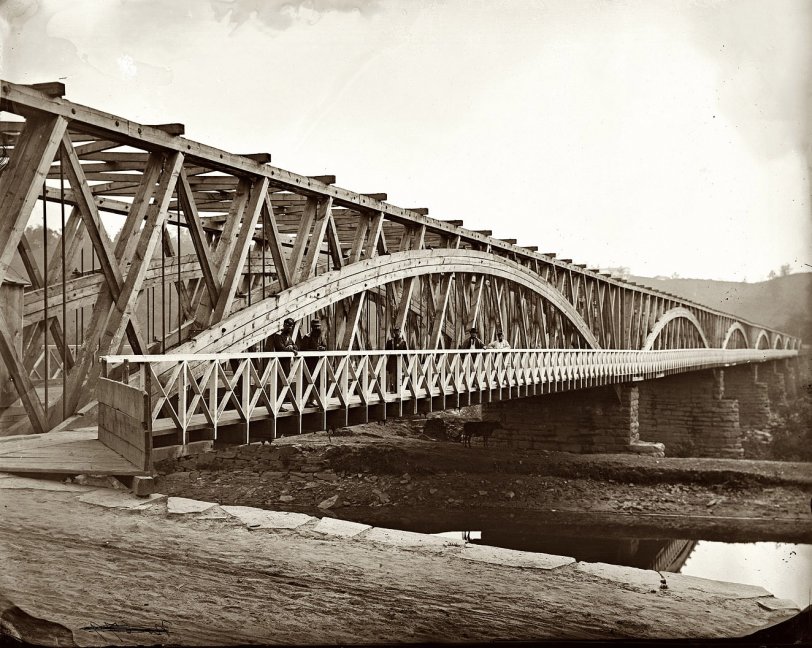


Framed or unframed, desk size to sofa size, printed by us in Arizona and Alabama since 2007. Explore now.
Shorpy is funded by you. Patreon contributors get an ad-free experience.
Learn more.

- Details, Details
- What's that building to the left of the tower?
- Coal Barges
- Bromo-Seltzer
- Inner harbor
- The Basin
- What a headache!
- Giant stepladder?
- Baldwin 62303
- Baldwin VO-1000
- Cold
- No expense spared
- Tough Guys
- Lost in Toyland
- And without gloves
- If I were a blindfolded time traveler
- Smoke Consumer Also Cooks
- Oh that stove!
- Possibly still there?
- What?!?
- $100 Reward
- Freeze Frame
- Texas Flyer wanted
- Just a Year Too Soon
- WWII -- Replacing men with women at the railroad crossing.
- Yes, Icing
- You kids drive me nuts!
- NOT An Easy Job
- I wonder
- Just add window boxes
Print Emporium
To the Other Side: 1865

The Chain Bridge over the Potomac River circa 1865, with the Chesapeake & Ohio Canal in the foreground. View full size. Wet collodion glass plate negative by William Morris Smith. From negatives compiled by Milhollen and Mugridge.
Chain Bridge
The entire structure is actually within the limits of the District of Columbia. The boundary line between Arlington, Virginia and Washington, D.C. is the high tide line on the Virginia side.
Chain Bridge
The C&O Canal and its towpath are still there also. The towpath is now a bicycling/walking trail from Georgetown to Cumberland, Md. 180 miles of history, scenery and good exercise!
Many "Chain Bridges"
The bridge in the photograph is one of many that have stood at this location, between Georgetown and Cabin John, north of McLean Virginia and spanning the Potomac. The "Chain Bridge" name itself dates from the 1810 incarnation, a suspension bridge designed by Judge James Finley. In 1801 Judge Finley designed & built the first modern suspension bridge, utilising iron chains and a level deck. This pioneering bridge is known as "The Jacobs Creek Bridge" and stood in Fayette County Pennsylvania.
No one really knows how old the modern Chain Bridge's piers are. Their footings date to sometime in the 19th century.
Chain Bridge
Where is the Chain Bridge? Is this the one north of McClean, VA?
[It's this one. - Dave]
wood
to build something like this out of wood? fantastic! commonplace at the time, but they're all gone now. happy for the picture(s)!
Bending timber
It was done with a steam box - of the same type as for bentwood for furniture or for carriage or sleigh pieces, just much larger. In the case of such large arch pieces, I imagine you would usually use superheated (pressurized) steam in the steam box.
But it would have been essentially muscle power - suitably magnified with old-fashioned mechanical advantage - that bent those massive beams and timbers. Amazing, eh?
Chain Bridge
The Chain Bridge was a real piece of work! Some very skillful carpentry work in the construction. This side view gives a good look at the pedestrian walkway that could be seen from the bridge interior in a previous photo.
I would like to have observed the process for bending large timbers for arches and ships' hulls. Presumably it was done with steam, but I'm unfamiliar with the procedures involved.
























On Shorpy:
Today’s Top 5